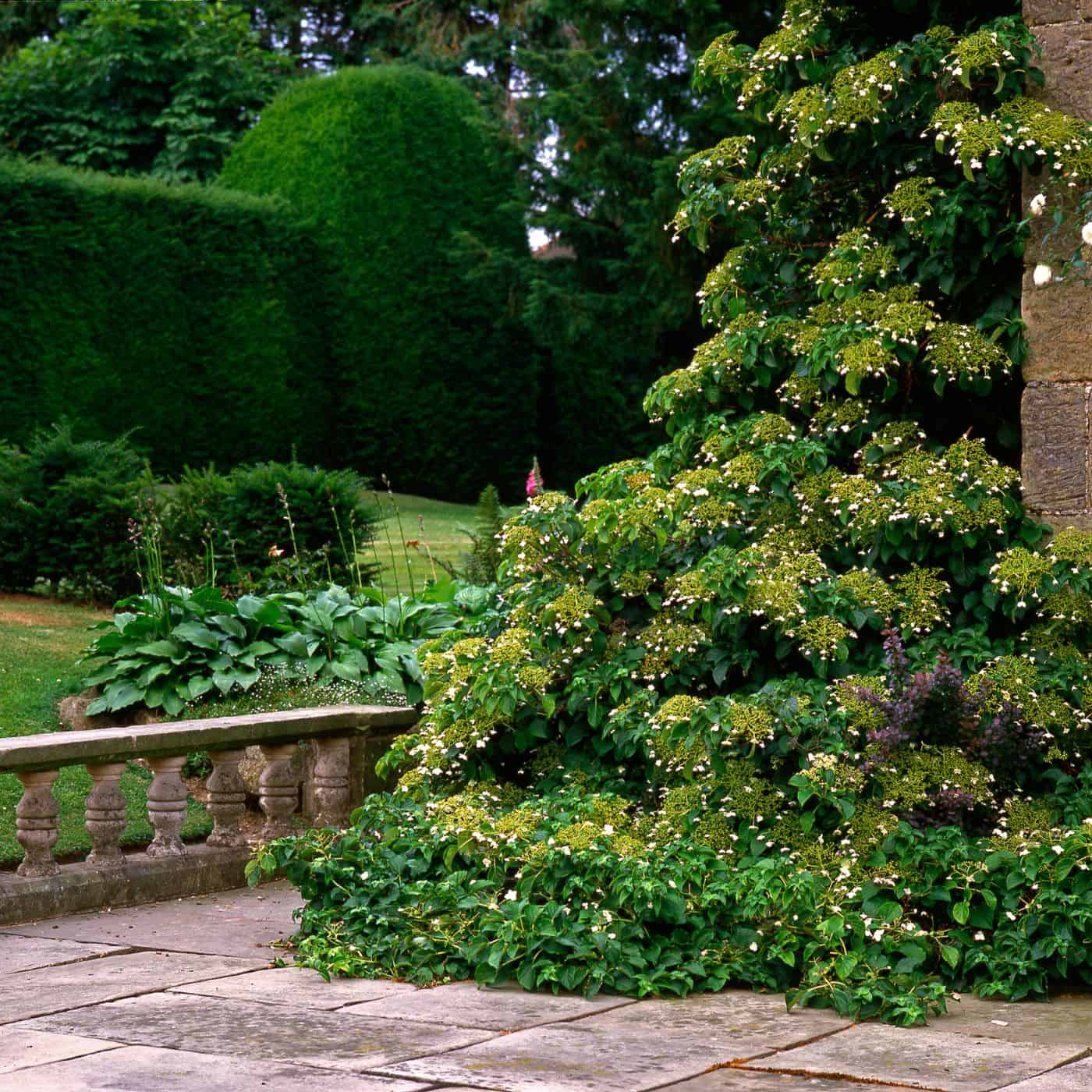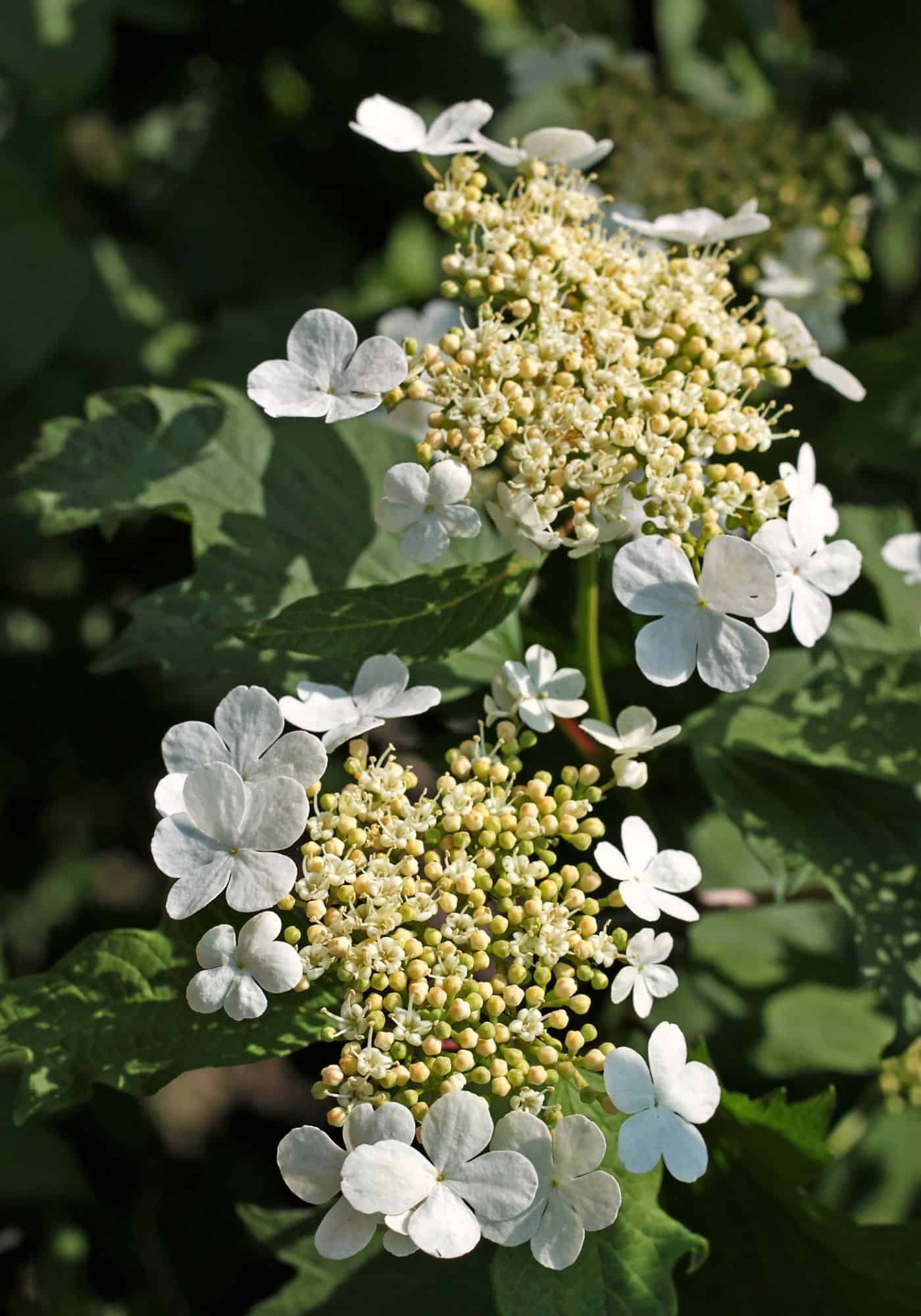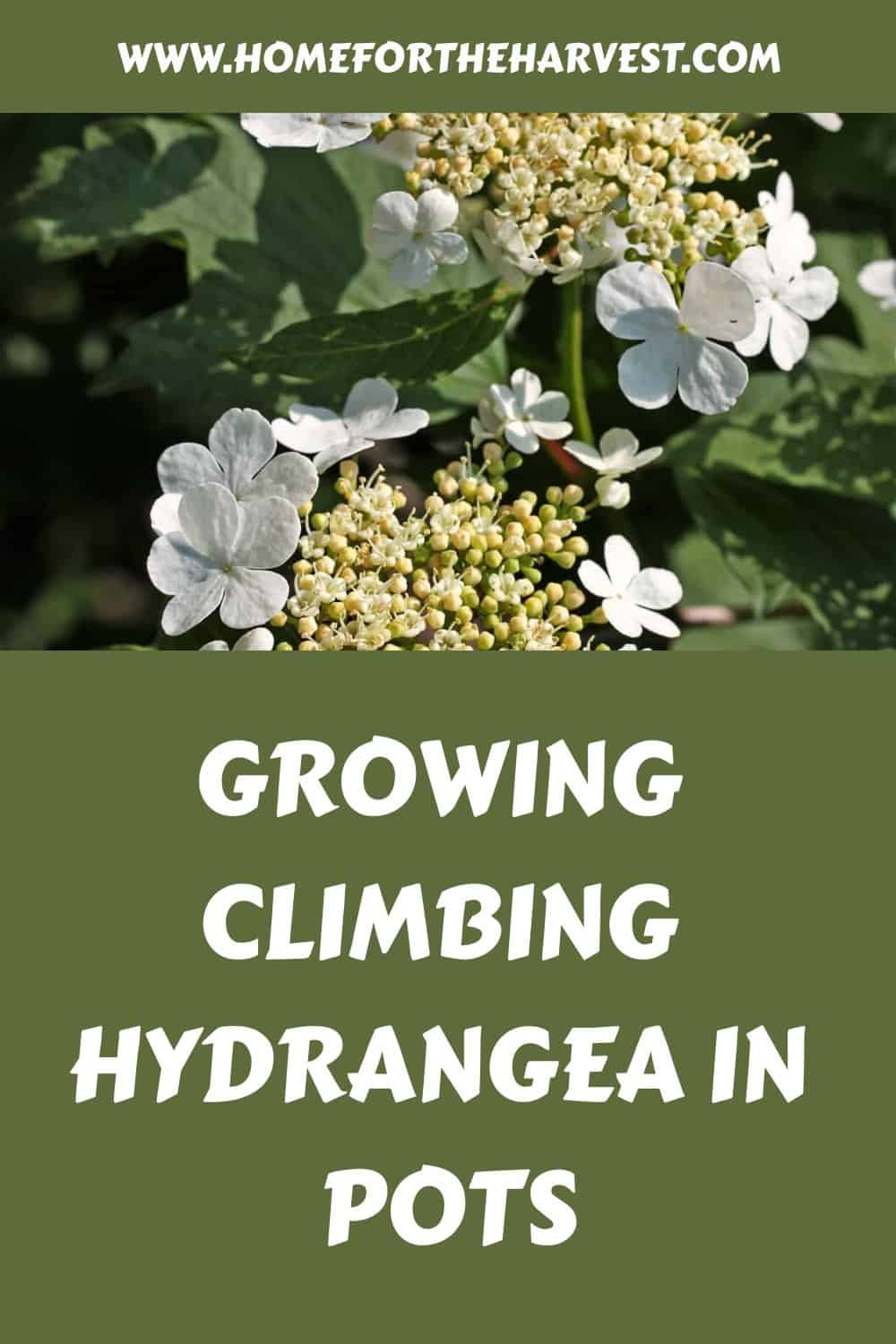To grow a climbing hydrangea in a pot, start by finding a large planter that’s a minimum of 18 inches tall and wide. The container should also have drainage holes.
Fill the planter with a blend of the garden’s high-quality potting mix, compost, and natural mineral soil. Plant the vine and keep it well-watered, avoiding letting the soil dry out completely. In cooler zones, you may wish to move the planter to a protected spot during harsh winter conditions.

Choosing the right planter for your climbing hydrangea
Size and material are important considerations when selecting a pot for your climbing hydrangea. The planter should be large enough to accommodate the plant’s root system and provide adequate drainage. A lightweight yet durable material is ideal if it can withstand weather conditions.
Clay or terra cotta pots are an excellent choice as they allow air circulation and moisture movement while providing insulation from extreme temperatures. Plastic or resin containers may also work well but need to be checked periodically for cracks or damage due to temperature changes. Wooden planters like old wine barrels work particularly well for larger vines like hydrangea. Just be sure to drill 3-4 drainage holes in the bottom.
Drainage holes and soil requirements must also be considered. The container should have several drainage holes in the bottom so that excess water can escape easily, preventing root rot or other issues caused by overwatering. Soil type is also important; use a light mix of peat moss, compost, and perlite for best results with this type of plant.
Placement is another key factor when growing a climbing hydrangea in a container garden setting; choose an area with partial sun or shade, depending on your local climate. If possible, move the container to a sheltered spot during cold winter months to protect against frost damage and keep away from strong winds, which could cause breakage or desiccation of branches over time.
Planting your climbing hydrangea in the pot
When preparing the soil, use compost or other organic matter that will provide proper drainage and nutrition for your plant. Mix it up with a high-quality potting mix that contains perlite or vermiculite. You’ll also want to add a bit of natural outdoor garden soil from the ground to add a bit of sand and clay grit.
Make sure not to bury any stems or leaves when planting at the same depth as it was in their original container. You can mulch the surface after planting and watering the vine but try not to pile any mulch up against the stem itself.
Adding a trellis can help support your climbing hydrangea while also providing an attractive backdrop against which it can grow. Look for one with sturdy construction that won’t easily topple over if windy conditions arise. It should be securely anchored into place along the base of the container so that it doesn’t move around during storms or strong winds.
After planting your climbing hydrangea in its new home, water thoroughly until all of the soil is saturated but not soggy. Mulching with composted yard trimmings can also help insulate the roots.
Then fertilize according to package instructions using either liquid fertilizer or slow-release granules applied directly onto wet soil every few weeks throughout spring and summer months only when actively growing (not during winter).
Caring for a climbing hydrangea during the growing season
The most important care factor for potted woody plants is to keep the soil moist. Pots dry out quicker than the soil in the ground. These plants, in particular, don’t like overly dry soil. The plant is completely dependent upon the gardener for water, so be sure to water it whenever the top two inches of soil dry out.
Pruning your climbing hydrangea is essential for its health and growth. Start by removing any dead or diseased branches, then shape the plant to your desired look. Ensure you don’t prune too much at once, as this can damage the plant. To train it, gently tie the base of the vines to the trellis or other support structure to help keep it growing in the right direction.
Climbing hydrangeas need plenty of sunlight to thrive, but they also need shade during particularly hot days and in the afternoon. Depending on the variety of climbing hydrangea vine you have and how harsh the sun is where you live, you may want to provide quite a bit of afternoon shade. Monitor how much sun your plant gets throughout the day and adjust accordingly if needed.
Keeping an eye out for pests such as aphids or spider mites is important when caring for your climbing hydrangea during its growing season. If found, take appropriate action immediately using natural methods like neem oil sprays or insecticidal soaps rather than chemical pesticides whenever possible. Regularly inspect leaves and stems for signs of infestation and act quickly if necessary.
Fertilize with a balanced fertilizer every month or so to promote healthy growth throughout the season. Follow package instructions carefully when applying fertilizer, as too much can harm plants.
Preparing your potted climbing hydrangea for winter in cold climates
Preparing your potted climbing hydrangea for winter in cold climates is essential to ensure it survives the colder months. While most climbing hydrangeas are winter hardy down to USDA Zone 4 when planted in the ground, they may only be hardy to Zone 5 or even 6 when planted in an aboveground container.
Consider some winter protection for climbing hydrangeas in pots in Zones 4 and 5, especially if the plant is in an exposed spot. Mulching around its base with straw or bark chips once the ground freezes will help protect the roots from fluctuating temperatures. Wrapping or covering with fabric like burlap can also help protect from frost damage, while moving indoors into a garage or workshop may be necessary in extreme cases of cold weather conditions.
Mulching to protect roots from freezing temperatures
To keep your climbing hydrangea safe during winter, mulch around its base with a thick layer of straw or bark chips before temperatures drop below freezing point. This will provide insulation and protection against any sudden temperature drops that could cause harm to the plant’s roots. Be sure to use organic material such as wood chips, pine needles, leaves, etc., as this will allow air and water to reach the soil more easily than synthetic materials like plastic sheeting would do.
Wrapping or covering with fabric to protect from winter damage
Another way you can protect your climbing hydrangea during winter is by wrapping the base up in a protective fabric such as burlap or canvas cloth once temperatures fall. This will create an extra layer of insulation between the plant and any temperature swings. Secure the fabric tightly to discourage wind from passing through it so you don’t create sags that snow could potentially gather in.
Moving a potted hydrangea for winter
In extreme cases where very low temperatures are expected for extended periods of time (such as when living in areas prone to heavy snowfall), it may be best practice for homeowners who want their plants protected throughout the winter season to consider moving them indoors into a warmer area or at least to a more sheltered outdoor spot until springtime arrives again.
Just make sure you place them somewhere so they won’t receive too much direct light during their dormant winter season. Instead, opt for gentle indirect light sources placed at least one foot away from the plant’s foliage whenever possible.
Enjoying a potted climbing hydrangea all year round!
Your climbing hydrangea can be the star of your outdoor space all year round! In spring, you can add a pop of color to the base of the planter with bright annuals like pansies and petunias. Use bedding plants from the garden center or even smaller dahlias for summer to create an eye-catching display. During autumn, opt for mums or ornamental kale that will bring in autumn hues. And finally, in winter, decorate with evergreen boughs or Christmas lights to keep your garden looking beautiful even when it’s cold outside.
When adding colorful accents to your climbing hydrangea, consider the colors already present in its blooms (generally cream-white) and foliage (glossy dark green) so that they complement each other well. You could also pick plants based on their texture; try combining soft flowers like mini roses with spiky succulents for contrast. If you want something more subtle but still interesting, go for low-growing groundcovers like creeping phlox or thyme, which will provide a nice backdrop without competing too much with the main attraction – your climbing hydrangea!
FAQs about climbing hydrangeas growing in pots
How long does it take for a climbing hydrangea to grow?
Climbing hydrangeas are a slow-growing plant at first, typically reaching heights of up to 3-5 feet in three years. They prefer moist, well-drained soil and can tolerate partial shade but will bloom best when planted in full sun. With the right conditions and regular pruning, climbing hydrangeas can reach their mature height within 5-10 growing seasons. When planting your climbing hydrangea it is important to provide adequate support for its growth as it will need something sturdy to cling onto as it grows taller. With the right care and attention, you can enjoy a beautiful climbing hydrangea in your garden for many years to come.
Does climbing hydrangea need a trellis?
Yes, climbing hydrangeas need a trellis. While rare when planted in pots, plants can grow up to 30 feet tall and require support to climb properly. A sturdy trellis should be placed near the base of the plant and securely anchored for best results. The structure should also be checked regularly for any signs of damage or decay that could affect its ability to provide adequate support. With proper care, your climbing hydrangea will thrive with a trellis as its support system!
Where is the best place to plant a climbing hydrangea?
The best place to plant hydrangea vines is in an area with partial shade and moist, well-drained soil. This shrub type prefers acidic soils rich in organic matter like compost. It should be planted near a structure such as a trellis, wall, or a fence for support. Make sure the planting site has enough space for its mature size and plenty of room for air circulation around the base of the plant. Water regularly during dry periods and mulch around the base of the plant to retain moisture and keep weeds away.
Is a climbing hydrangea sun or shade?
Climbing hydrangea is a shade-tolerant plant that needs a bit of gentle sunlight to flower well but can tolerate partial or full shade. It can tolerate some sun but will not thrive if exposed to too much direct sunlight for long periods of time. When planting a climbing hydrangea, make sure the area you choose has enough light to grow and bloom properly without being overexposed to intense heat from the sun.







